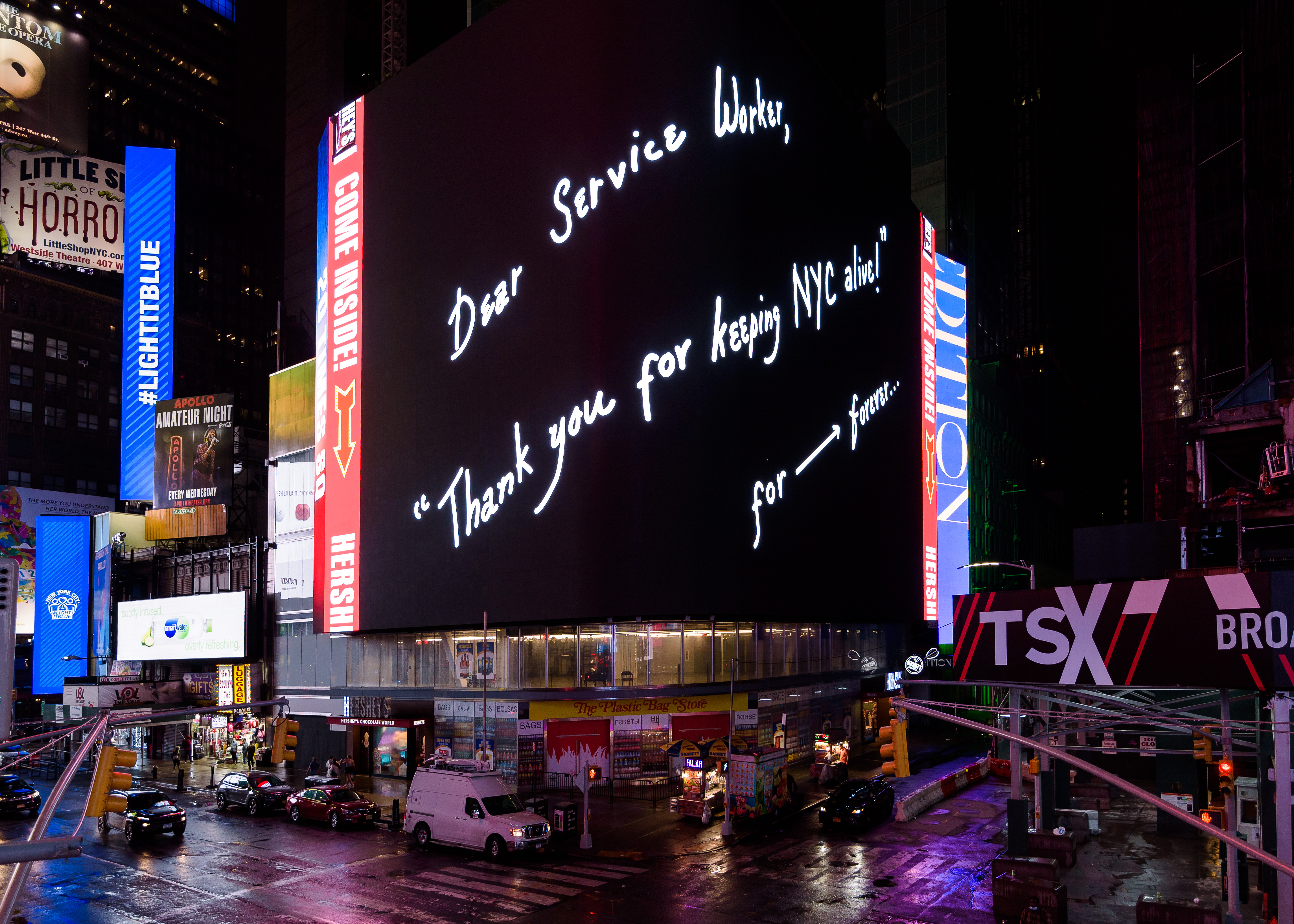
The past six months have opened a lot of people’s eyes to the importance of unsung, so-called essential laborers. For Mierle Laderman Ukeles (1939–), the fundamental need to honor such workers has been at the heart of her work for decades.
Since 1977, Ukeles has been the official artist-in-residence at the New York City Department of Sanitation, where she famously shook the hand of each and every one of its 8,500 employees in an 11-month-long performance titled Touch Sanitation (1979–80). She told each worker “thank you for keeping New York City alive.”
Now, her message is being be amplified across the city, with public art installations in Times Square, on the facade of the Queens Museum, and across 2,000 digital-advertising spaces in the subway system. The new project, titled For ⟶ forever…, addresses service workers, and acknowledges the never-ending nature of their labor.
“The work isn’t going to be done,” Ukeles told Artnet News. “It’s not like you work, work, work so hard and it’s finished, like a painting.”
Mierle Laderman Ukeles, For⟶forever… (2020). Photo ©Mierle Laderman Ukeles by Ian Douglas/Times Square Arts.
Ukeles’s messages, although digital, are handwritten in a nod to the personal nature of her work. But at 81, she’s firmly in the at-risk category, and has been largely confined to her apartment in Israel.
“I can’t shake your hand. I can’t even be there to be with you to say this face to face,” Ukeles said.
Her last trip to New York was in March. Upon her return home, she watched events in New York unfold from across the ocean. As the city reopened, friends would update her on the state of things.
“They kept talking about how clean the subway is,” Ukeles said. “That’s because workers are in there making it safe for people to come back. And in the process of making it safe for people to come back, they expose themselves.”
Mierle Laderman Ukeles, For⟶forever… (2020). Photo ©Mierle Laderman Ukeles by Marc A. Hermann/MTA New York City Transit.
When the Queens Museum, where she had her 2016 retrospective, approached her, together with Times Square Arts and MTA Arts & Design, she was eager to make a public artwork calling attention to and celebrating the service workers who had kept the city running.
“Many people are out there thanking health workers. They are truly heroic. But this piece is about service workers,” Ukeles said. “They need to be honored.”
The roots of Ukeles’s interest in menial labor and its never-ending nature can be traced back to 1969, when she composed her Maintenance Art Manifesto.
Mierle Laderman Ukeles, I Make Maintenance Art One Hour Every Day (1976), installation shot (2016). Photo by Hai Zhang, courtesy of the Queens Museum and Ronald Feldman Fine Arts, New York.
The year before, she had given birth to her first child, and quickly realized that parenthood constrained her in a way that didn’t apply to the male artists she considered her heroes. “I realized Jackson [Pollock] doesn’t change diapers,” Ukeles said.
The defiantly feminist manifesto boldly proclaimed that all her household tasks and other chores, which had to be done again and again as part of the routine maintenance of everyday life, would henceforth be considered her artwork.
“I was working like a lunatic, trying to be an artist, trying to be a mother,” Ukeles said. The manifesto “developed out of being so pissed off that people didn’t see what I was doing. What I was doing as a mother wasn’t seen.”
ArtForum published the Maintenance Art Manifesto in 1971, and Ukeles made good on its words. In 1973, she mopped the steps of the Wadsworth Atheneum Museum of Art in Hartford, Connecticut, for a performance titled Washing/Tracks/Maintenance: Outside.
Then Ukeles turned her eye to the invisible labor of others, documenting—and thereby elevating—the activities of 300 maintenance workers at the Whitney Museum for I Make Maintenance Art One Hour Every Day (1976).
Mierle Laderman Ukeles, Touch Sanitation Performance, 1979-1980. Image courtesy of the artist and Ronald Feldman Fine Arts, New York.
She sent a selection of press clippings to the sanitation commissioner, who extended an invitation to scale up. Why settle for 300 maintenance workers, when you could work with 10,000? (The position was and is unpaid.)
“I felt like I had been invited to come up to the major leagues of maintenance world,” Ukeles said.
Greeting each sanitation worker helped spotlight the contributions of a labor group that is often invisible, even though, unlike office workers, they work out on the streets, in public.
“We are, all of us, whether we desire it or not, in relation to sanitation, implicated, dependent if we want the city, and ourselves, to last more than a few days,” Ukeles in wrote in the Sanitation Manifesto! (1984). The truth of that declaration was never more apparent than during lockdown, when sanitation workers went to work, supporting the doctors and nurses so that the rest of New York could stay at home.
“The streets of New York used to be an accumulation of weeks and months of garbage, and people would walk around on that,” Ukeles said. No more—and for that, we have service workers to thank.”